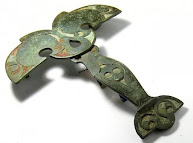 |
The harness-brooch |
The gist of the matter is that a British metal detectorist found an intact (though damaged) large piece of Celtic enamelled metalwork, and had it cleaned, photographed, written up by the auctioneer and on sale by auction. Nowhere along that line was recording with the PAS involved. It is my understanding that objections to the undocumented sale were raised from some quarters and miraculously at the last moment (four days before the auction, and largely using material supplied by the auctioneer), a PAS write-up of this harness-brooch appeared online. This apparently legitimised the object that was then sold for some seven times its original estimate. On the face of it, it would appear from this that the PAS was involved in the process of price-hiking. The PAS database is intended as a long-term deposit of information, not an auction-news service, there was no reason not to wait with publication of this record until after the sale was finished.
Actually getting information out of the PAS and the BM about how this came about proved to be difficult. I am still waiting for substantive replies to my queries from: The Bucks FLO, the DENO FLO and Julia Farley. None of them seem to accord any urgency to explaining away the PAS involvement in this sale. I am reliant on the published information, the auction catalogue and Searcher article, both written by Adam Staples of the auction house, the PAS database record and its metadata, which is heavily based on the auction catalogue and Searcher article (reportedly with two pieces of information from the finder), and the emails written to me by the Head of the PAS after one of his FLOs had refused to answer my queries and referred me to him, apparently as being a person who knows more about what goes on in her own office than she herself does. Wow.
The Discovery
 |
| The discoverer |
Mr Pusey, a detectorist for 30 years, confessed he nearly didn't go out that day but found the brooch eight to ten inches underground after about an hour of searching. He said: "I watched the auction online [...] It was an exceptional result and so exciting to watch. "The money will be split 50/50 split with the landowner and, when I went round to tell him, he nearly fell over. "Me and my wife are having a Chinese to celebrate tonight".Buckinghamshire until the national lockdown was recently in Tier 4 (the highest risk zone) and Mr Pusey should not have been "going round to see him" at all, but the phrase suggests that the farm is very local to Mr Pusey's home. Note, that all the operations describes as occurring after October 2020 were also in what became high-level lockdown zones (tiers 3 and 4).
If Mr Pusey has been detecting 30 years, he'd have started about 1990, so would have had to be an utter recluse not to have heard of the PAS and what it is there for. He, however, decided not to contact the FLO, but go ahead and get it cleaned and sold.
There are two puzzles about this. First of all, who measured and recorded the "weight" of the object (169g) and why? It appears in the auctioneer's catalogue. The significance of this is that this is one of the more useless data fields of a PAS record. If Mr Pusey weighed the object, it could be that the van-driver was aware that PAS archies weigh their stuff. The second conundrum is that there is (reportedly) a 10-figure NGR recorded for the findspot, which means (unless it was built into the detector) a GPS was being used in the field. Why would a metal detectorist be doing this if there was no intent to report it to the PAS? Puzzling.







No comments:
Post a Comment